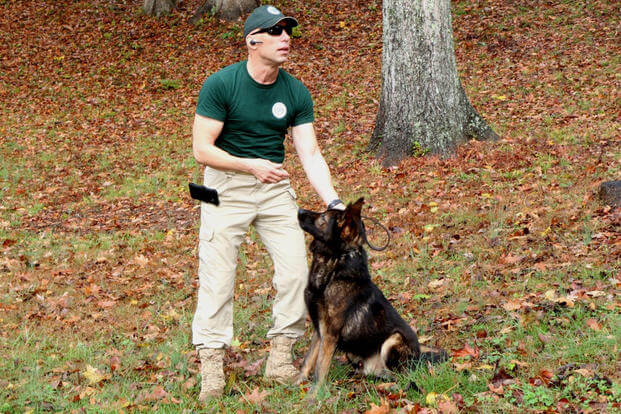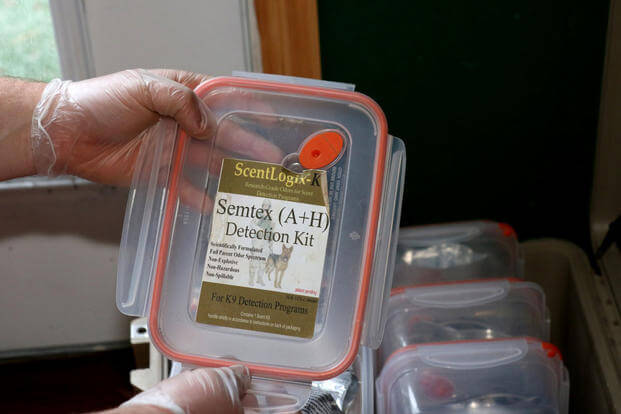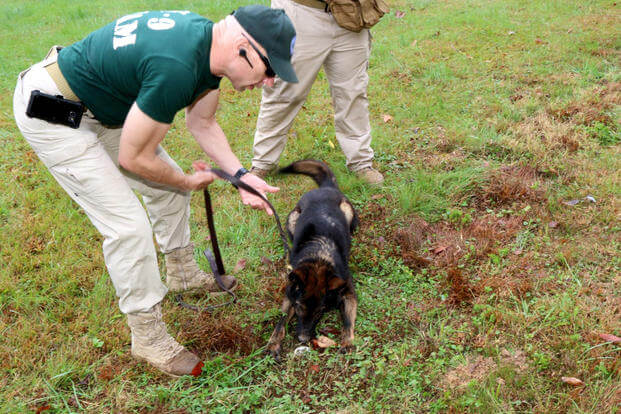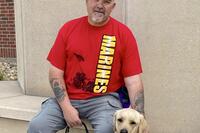Veteran K9 trainer Shawn Deehan shadows a Czechoslovakian shepherd named Bojar as he searches a large field, following hints of explosives in the air.
The wolfish-looking animal keeps his nose just above the rain-soaked grass, moving forward in overlapping circles.
"So as he makes a big circle, I walk up to the back side of the circle; he does another and I walk up to the next one and I know that area is clear," Deehan says. "He's clearly bracketing in this general area. I try to stay out of it as much as possible.
"OK, that was a hard bracket. OK, there he goes. He's got it."
Bojar lays down -- body rigid -- and fixes his above a concealed section of PVC pipe that holds the scent of Semtex plastic explosive.
The demonstration of olfactory prowess isn't unheard of in the world of military working dogs.
The difference here, Deehan maintains, is his dogs are trained on a new behavioral model he developed that's based on "honest evolutionary behaviors."
"What happens to the dog's brain is a series of reactions through their data sensory input organs -- eyes, ears, nose, mouth, tongue, paws, skin -- and that data sensory input causes their brain to react with either evolved reactions or conditioned reactions," he said.
"This is a profoundly new and different behavioral science model and that has enabled us to have a dog that can find a piece of scotch tape inside a room in 10 seconds that has got bomb or drug odor on it."
Deehan is the president and founder of Global Dynamic Security -- a secluded, wooded training compound near Fredericksburg, Virginia, that offers a range of security services to include protection details as well as training programs for law enforcement and security agencies.
Since Deehan formed the company five years ago, one of his primary focuses has been to develop a new standard for providing highly trained, tactical K9s for use by U.S. and allied special operations forces.
Deehan officially launched the effort in July and is now seeking clients.
"These are tactical K9s; they are capable of joining with a tactical special operations unit and functioning in a way that is more valuable than any other member of that team in my humble opinion," he maintains.
Deehan began training with working dogs 25 years ago. He started out working with biting dogs, which are used for personal and executive protection and can be the most challenging to handle, he said.
"You cannot make a mistake; if you make a mistake, they literally bite someone in the face," said Deehan.
He became an expert for large-breed, aggressive dogs for Washington, D.C.-area agencies such as Fairfax, Prince Georges and Montgomery counties, he said.
During that time, Deehan started to realize that the assumptions people made about dogs was based on a false premise.
Related Video:
"That behavioral model was that the animal is thinking and making cognitive, reasoning decisions; it's going through a reasoning process -- I am mad, so I am not going to do what you say today when in fact it is quite different," Deehan maintains.
"Dogs are binary, their brain is binary. Everything is a zero or a one. It's a yes or a no; a go or a stop," he said. "And that behavioral science model has proven true with everything I have done with them."
GDS's specially designed kennels currently house 15 large-breed dogs. Four of them are trained detection dog that specialize in finding scents such as explosive and drug odors. The others are used in the training program to teach skills such as obedience.
Dog selection is critical, said Deehan, who prefers to use Dutch and Czechoslovakian shepherds. These dogs are bred to be very intense, making them perfect for detection work, he said.
"Our dogs are odor driven," Deehan said. "We unhook the leash ... because wherever the odor is, our dogs will go to it. We let them lose 80 yards away. You see them working the odor, not just running to the building. They smell it in the wind, on the ground, collected on objects. They are so sensitive to odor that anywhere odor has flowed or collected they will indicate on that and we have trained them to indicate on varying levels.
"If a dog goes to a door and they are sniffing intensely, but they don't give a final response, we know that means there is explosive or ammunition or drug odor inside, but it is not close to the door that tells special ops kick the door open there is stuff inside."
One the main differences Deehan has with many conventional dog trainers is they work their dogs too long.
"The conventional community overworks dogs to the point of complete ineffectiveness," Deehan said. "They exhaust them. ... They can't go beyond 30 minutes and be effective. At that point you run the risk of the dogs not indicating and people getting killed."
Oklahoma Police Master Sgt. Gregory Vollmer agrees with Deehan. Vollmer works with the National Tactical Police Dog Association as an evaluator and dog trainer.
Vollmer routinely helps sweep a local sports stadium in Norman, Oklahoma, with explosive-sniffing dogs. They have to use multiple dogs to clear the stadium before and event.
"The stadium sweep takes each dogs about 30 minutes," he said. "By that time, they are ready to take a nap."
Some dog trainers insist that their dogs be trained for up to four hours a week, Deehan said.
"Our training is much more efficient; we train our dogs seven or eight or ten minutes a week and our dogs blow them away," Deehan said, pointing out that his dogs are much more intense on the search if they are rested. "We are recognizing the real limitations of the animal."
Vollmer said he has seen a lot of different training techniques in his nine years of working with detection dogs, and he is always interested in learning something new.
"There is a lot of good training out there, and I learn something new every day," he said. "If you've got a dog that can run around and hunt these odors, then you've got a dog that can find anything that you teach him to find."
GDS charges $110,000 for one trained dog. For that fee, Deehan will select the dog and train the animal for six weeks. Then the handlers will be brought in for a six-week training course where they learn the behavioral science model and the obedience method that allows the animal to operate with a tactical team, Deehan said.
"We complete their training with the handlers in four months," he said.
Aside from the training, the package includes "everything they need -- the odor kits, two GoPro cameras so they can video every search and upload it to a cloud and then to a computer that we provide them. And we monitor the dogs for one year," Deehan said.
GDS will also provide plans for the construction of custom-designed kennels to ensure clients get the maximum performance out of the dog, Deehan said.
"We are not training retrieval dogs, we are not training treat-eating dogs, we are not training live-in-the-house-with-me dogs," Deehan said. "We are training dogs to find bombs, so this guy doesn't get his legs blown off.
"This is about counter-terrorism. This is an offensive counter-terrorism asset that is unbeatable. These dogs can find a terrorist sitting in a full restaurant and take you right over to him by the explosive odor on his hands."
-- Matthew Cox can be reached at matthew.cox@military.com





























